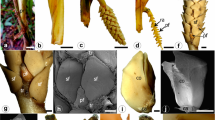Abstract
The shoot organization and inflorescence structure ofEpithema is analyzed. On the main axis micro- and macrocotyledon (the latter falling off early) are followed by a ± long epicotyl, then a large, solitary leaf (B3) and above this a dimerous leaf whorl (B4, B5). The last internode of the main axis is the “basic internode” of the “main florescence” (Troll). Peculiarly enough, the latter includes only one “partial florescence” which is embraced by its subtending bract (B6) and represents a capitulum-like, congenital, pair-flowered cincinnus. Paracladia arise from the axils of B3 to B5 (sometimes also from the macrocotyledon); they are either reduced to their co-florescence (with the same structure as the main florescence), or carry further shoots resp. co-florescences from the axils of a dimerous leaf whorl.—Epithema can be interpreted as anisophyllous.—From flower morphology and ontogenesis a number of new differential characters are revealed. Together with shoot and inflorescence characters their systematic and possible functional significance is discussed.
Similar content being viewed by others
Literaturverzeichnis
Blume, C. L., 1826: Bijdragen tot de Flora van Nederlandsch Indië. Batavia: Ter Lands.
Burtt, B. L., 1958: Studies in theGesneriaceae of the Old World. XIII. Miscellaneous transfers and reductions. Not. Roy. Bot. Gard. Edinb.22, 305–314.
Burtt, B. L., 1962: Id. XXIII.Rhynchoglossum andKlugia. Not. Roy. Bot. Gard. Edinb.24, 167–171.
—, 1963: Id. XXIV. Tentative key to the tribes and genera. Not. Roy. Bot. Gard. Edinb.24, 205–220.
—, andWoods, P. J. B., 1975: Id. XXXIX. Towards a revision ofAeschynanthus. Not. Roy. Bot. Gard. Edinb.33, 471–489.
Chevalier, A., 1911: Novitates Florae Africanae. Mém. Soc. Bot. France8, 1–224.
Clarke, C. B., 1874:Commelynaceae etCyrtandraceae Bengalenses. Calcutta: Thacker, Spink & Co.
Fritsch, K., 1904: Die Keimpflanzen der Gesneriaceen, mit besonderer Berücksichtigung vonStreptocarpus, nebst vergleichenden Studien über die Morphologie dieser Familie. Jena: Fischer.
Gardner, G., 1846:Epithema ceylanica. Calcutta J. Nat. Hist.6, 492–493.
Goebel, K., 1898: Organographie der Pflanzen, insbesondere der Archegoniaten und Samenpflanzen. 1. Teil. 1. Aufl. Jena: Fischer.
Hallé, F., etDelmotte, A., 1973: Croissance et floraison de la Gesnériacée africaineEpithema tenue C. B.Clarke. Adansonia13, 273–287.
Hartl, D., 1963: Das Placentoid der Pollensäcke, ein Merkmal der Tubifloren. Ber. Dtsch. Bot. Ges.76, (70)-(72).
Ivanina, L. I., 1965: Application of the carpological method to the taxonomy ofGesneriaceae. Not. Roy. Bot. Gard. Edinb.26, 383–403.
Jong, K., 1970: Developmental aspects of vegetative morphology ofStreptocarpus. Unpubl. Thesis. Edinburgh.
—, andBurtt, B. L., 1975: The evolution of morphological novelty exemplified in the growth patterns of someGesneriaceae. New Phytol.75, 297–311.
Leinfellner, W., 1950: Der Bauplan des synkarpen Gynözeums. Österr. Bot. Z.97, 403–436.
Müller, P., 1936: Über Samenverbreitung durch den Regen. Ber. Schweiz. Bot. Ges.45, 181–190.
Pascher, A., 1960: Über die Wasserkelche vonDatura undAnisodus und über das Vorkommen freien Wassers in den Bälgen vonPaeonia. Flora148, 517–528.
Schenk, W., 1943: Morphologisch-anatomische Untersuchungen an der GattungStreptocarpus. Bot. Arch.44, 217–284.
Schmidt, H., 1908: Systematisch-anatomische Untersuchungen des Blattes der Campanuloideen. Diss. Erlangen.
Solereder, H., 1908: Systematische Anatomie der Dicotyledonen. Erg.-Bd. Stuttgart: Enke.
Trapp, A., 1954: Staubblattbildung und Bestäubungsmechanismus vonIncarvillea variabilis Batalin. Österr. Bot. Z.101, 208–219.
Troll, W., 1937: Vergleichende Morphologie der höheren Pflanzen. Bd. 1. Teil 1. Berlin: Borntraeger.
—, 1951: Botanische Notizen II. 2. Zur Kenntnis der Zingiberaceenblüte. 3. Über den Griffelhalter derJacobinia- undBeloperone-Blüte. Abh. Akad. Wiss. Lit. Mainz, Math.-Naturw. Kl., Jg. 1951, 25–33.
—, 1964: Die Infloreszenzen. Typologie und Stellung im Aufbau des Vegetationskörpers. Bd. 1. Jena: Fischer.
Wallich, N., 1832: Plantae asiaticae rariores. Vol. 3. London: Treuttel, Würtz & Richter.
Ulbrich, E., 1928: Biologie der Früchte und Samen (Karpobiologie). Berlin: Springer.
Weber, A., 1971: Zur Morphologie des Gynoeceums der Gesneriaceen. Österr. Bot. Z.119, 234–305.
—, 1973: Die Struktur der paarblütigen Partialfloreszenzen der Gesneriaceen und bestimmter Scrophulariaceen. Beitr. Biol. Pflanzen49, 429–460.
—, 1975a: Beiträge zur Morphologie und Systematik derKlugieae undLoxonieae (Gesneriaceae). I. Die Sproß- und Infloreszenzorganisation vonMonophyllaea R.Br. Bot. Jahrb. Syst.95, 174–207.
—, 1975b: The cristate inflorescence ofChirita sect.Microchirita. Not. Roy. Bot. Gard. Edinb.34, 221–230.
—, 1976a: Beiträge zur Morphologie und Systematik derKlugieae undLoxonieae (Gesneriaceae). II. Morphologie, Anatomie und Ontogenese der Blüte vonMonophyllaea R.Br. Bot. Jahrb. Syst.95, 435–454.
—, 1976b: Id. III.Whytockia als morphologische und phylogenetische Ausgangsform vonMonophyllaea. Beitr. Biol. Pflanzen52, 183–205.
Wight, R., 1850: Icones plantarum Indiae orientalis. Vol. 4. Madras: Franck & Co.
Wilson, C. L., 1974: Floral anatomy inGesneriaceae. I.Cyrtandroideae. Bot. Gaz.135, 247–256.
Wood, D., 1970: The role of marginal hydathodes in foliar water absorption. Trans. Bot. Soc. Edinb.41, 61–64.
Author information
Authors and Affiliations
Additional information
Teil IV der „Beiträge zur Morphologie und Systematik derKlugieae undLoxonieae (Gesneriaceae)“.
Frau Univ.-Prof. Dr. E.Tschermak-Woess zum 60. Geburtstag gewidmet.
Rights and permissions
About this article
Cite this article
Weber, A. Wuchsform, Infloreszenz- und Blütenmorphologie vonEpithema (Gesneriaceae). Pl Syst Evol 126, 287–322 (1976). https://doi.org/10.1007/BF00983367
Received:
Issue Date:
DOI: https://doi.org/10.1007/BF00983367




